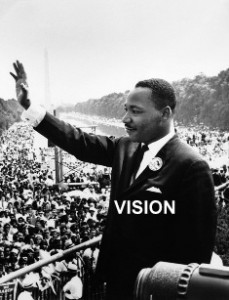Dreaming and thinking big are essential to visionary leadership. All true leaders have the ability to articulate their vision for the future. Vision is the ability to see things, as they should be, not as they are. Rudyard Kipling clearly understood the importance of vision. He knew that one’s vision must compel action and drive change. The fifth couplet from his classic poem ‘If-’encourages us to dream and think.

If you can dream – and not make dreams your master;
If you can think – and not make thoughts your aim,
Every leadership theory has vision at its core. It does not matter what we call it – vision, dream, aspiration, cause, mission, etc. What matters is that it has certain essential elements. A vision expresses a desire to do something meaningful. It is an articulation of a future that is different (and presumably better) than today. It gives our followers a general idea of the direction we will take. Most importantly, a vision demonstrates a leader’s personal commitment to it. Consider vision in the context of a journey. Our vision says where we want to be, why we want to be there, how we can best get there, and what is required to reach our destination.
What prompts us to take our vision out of the realm of thought and into the real world? Most people have visions, but some visions never leave our heads. We think, “Wouldn’t the world be better if…?” This is where the vision ends; it is never stated and it compels no one to act. Compelling visions generate energy, excitement and passion. They are communicated clearly and consistently. They are repeated often, and they are spoken with excitement. They cause others to embrace them as their own. They drive us to take action and to invest ourselves in making them real. A compelling vision motivates ordinary people to do extraordinary things. Truly compelling visions inspire entire organizations or even societies to align behind them.
Each of us is motivated and inspired by our own dreams. Leaders like King, Reagan, Churchill, Thatcher, and Gandhi had the ability to dream and to articulate their vision in a way that draws us in. How can we learn from their visions and lead more powerfully and effectively?
- Acknowledge the power of a compelling vision. People need a vision to follow. They want to know they are part of something bigger than themselves, and a compelling vision gives us something to which we can aspire.
- Our vision must be rooted in our values, beliefs, and principles. Our vision should also reflect who we are and what we believe. Our passion for our vision will attract those we wish to lead. When we believe in our vision, people know it.
- Our vision should speak to both our core and extended stakeholders. To our base it must say, “Our leaders understand this problem, and here is a way to solve it.” To the broader stakeholder group it must say, “This problem is bad for all of us, and this solution will fix it without causing us harm.” Compelling visions motivate us by first speaking to our hearts and then to our minds. They can motivate us to deliver extraordinary results.
- Our vision reveals the power of being audacious while remaining credible. We must strive to find the right balance between big and believable when articulating our vision. We build credibility by proving our capacity to achieve what we propose, our appreciation of how big our vision is, and our awareness of what we will need to achieve it.
- In order for our visions to take hold, we must articulate them simply and clearly, and then we must repeat them with conviction. We may begin to think we are sounding like a broken record. We must remember that people will need to hear our vision many times before it sinks in. Finally, we need to remember that simplicity keeps our message clear and memorable. Keep it simple, and keep repeating it.
Our vision can enable us to motivate and inspire others to act. True leaders understand the importance of dreaming and thinking big. They heed Kipling’s advice to “dream and not make dreams your master and think and not make thoughts our aim.”
Testimonials
Ph.D., Director, Gilliam Center for Free Enterprise and Ethical Leadership and Professor, Management Department, College of Business, James Madison University
Ph.D., Director, Gilliam Center for Free Enterprise and Ethical Leadership and Professor, Management Department, College of Business, James Madison University
President, AAISP – DC
P.Eng., President ACT Canada
President, Arneson Leadership Consulting
(Steve was named one of the country's Top 100 thought leaders on leadership in 2008, 2009 and 2010, and one of the Top 25 leadership coaches in America for 2008, 2009 and 2010 by Leadership Excellence magazine. )
Former Governor and Senator, Commonwealth of Virginia
EVP and CFO, Intersections, Inc.
(USN ret.), former POW
President, Financial Services, Capital One
CEO, Korea Exchange Bank
formerly management columnist at the FT, now Visiting Professor at the Cass Business School, London, and director of strategy at Edelman in the UK
former Commanding Officer, USS Dwight D. Eisenhower, CVN-69, and recipient of the John Paul Jones 'Inspirational Leadership Award' from the Navy League of the US.
Professor Emeritus, Darden Graduate School of Business, University of Virginia
Co-author Anytime Coaching: Unleashing Employee Performance Adjunct Professor, Johns Hopkins Carey Graduate School of Business
Bishop Emeritus of Richmond
Professor Emeritus, Darden Graduate School of Business, University of Virginia.
Head Coach, Butler University Men’s Basketball Team
Managing Director, Merrill Lynch Wealth Management
Author of Be Your Own Coach, and On Becoming a Leadership Coach, and creator of the Georgetown University Leadership Coaching Program





